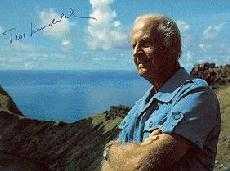
Heyerdahl is a great Norwegian explorer who is still going strong. The colourful 80-year-old Norwegian is describes as part showman, part adventurer, part archaeologist, and part Norwegian Viking. He has also showed unique abilities to build good relationship with people world wide.
Photo: Thor Heyerdahl - one of Norway`s many great explorers.
Thor Heyerdahl was born in Larvik, Norway on the 6 October in 1914. He originally was a student of Zoology, but while he and his wife were studying wildlife in the Marqueses Islands he became more interested in how the islands were populated. This was the beginning of an incredible carrier. The prevailing theory was that the Polynesian Islands were populated from the east. Heyerdahl noticed that the winds and streams came from east to west, so it was possible that people had to travel from South America.
This led to the Kon-Tiki Expedition in 1947 in which Heyerdahl wanted to prove his theory of cultural diffusion. Balsawood boats (raft) were built according to the traditions of South American Pre-Colombian Indians. Heyerdahl and his crew of five crossed 4,300 miles (8000 km) of open ocean taking 101 days, facing storms, whales and sharks.
They finally landed on the Polynesian Island of Raroia, proving that people from South America could have settled the Polynesian Islands. Before the voyage, he had been given a camera to film his great adventure. The film was put together into a documentary and the film won an Academy Award for Outstanding Documentary in 1952.
One of these was the first Norwegian expedition to Easter Island in 1954 when the mysteries of the island were revealed. This was the start of a long series of archaeological excavations headed by Heyerdahl. In 1969, Heyerdahl undertook the RA expedition to prove that ancient Egyptian mariners could have crossed the Atlantic Ocean in papyrus reed boats. This could account for the pyramid structures built in Central America. His boat made it across the Atlantic Ocean, but sank 600 miles from its destination in the Caribbean Sea. This time ethnologists on linguistic reasons rejected his theories.
In November of 1977, the Tigris Expedition began. Heyerdahl wanted to establish the possibility that ancient Sumerians might have used reed boats to spread their culture. Heyerdahl and his crew of eleven set out on the voyage from the Tigris River in Iraq. Over the next four months, they would travel out of the Persian Gulf, across the Arabian Sea to Pakistan and back across the Arabian Sea. Their journey finally ended 4,000 miles later in the Red Sea.
On of his latest discovery, which came in the late 1980`s and which is still being excavated, are the pyramids of Pyramids of Tu'cume in northern Peru. The pyramids were constructed 9 centuries ago by the people of the Lambayeque culture. Several important items were recovered such as silver figurines, featherwork textiles, lapis lazuli from Chile, and shells from Ecuador and Panama.
The most important discovery for Heyerdahl was a frieze depicting reed boats, exactly the type Heyerdahl had foreseen. The unearthed artefacts supported his controversial theory of a migration from the South American continent westward to Easter Island.
Since his first expedition, Thor Heyerdahl has led many expeditions that have attracted international attention. He has published several books. It is interesting to read about his achievements and explains for connections between his theories and his many expeditions.
Thor Heyerdahl`s continuously hard work, expeditions, visions, humour and environmental awareness helps making the world a more interesting place to live.
Stein Morten Lund, 28 July 2000
Additional information
Read more about Heyerdahl`s ongoing expeditions on our website.
